

This digital edition published by Parragon Books Ltd in 2015
LOVE FOOD is an imprint of Parragon Books Ltd
Parragon Books Ltd
Chartist House
1517 Trim Street
Bath BA1 1HA, UK
www.parragon.com/lovefood
Copyright Parragon Books Ltd 2015
Copyright 2015, Tart Workshop with Reserved Font Name Butterfly Kids
LOVE FOOD and the accompanying heart device is a registered trademark of Parragon Books Ltd in Australia, the UK, USA, India and the EU.
All rights reserved. No part of this publication may be reproduced, stored in a retrieval system or transmitted, in any form or by any means, electronic, mechanical, photocopying, recording or otherwise, without the prior permission of the copyright holder.
ISBN 978-1-4723-9887-1
10 8 6 4 2 1 3 5 7 9
New recipes and text written by Christine McFadden
New photography by Haarala Hamilton
Edited by Fiona Biggs
Notes for the Reader
This book uses both metric and imperial measurements. Follow the same units of measurement throughout; do not mix metric and imperial. All spoon measurements are level: teaspoons are assumed to be 5 ml, and tablespoons are assumed to be 15 ml. Unless otherwise stated, milk is assumed to be full fat, eggs and individual vegetables are medium, pepper is freshly ground black pepper and salt is table salt. Unless otherwise stated, all root vegetables should be peeled prior to using.
The times given are an approximate guide only. Preparation times differ according to the techniques used by different people and the cooking times may also vary from those given.
 Though currently on-trend, using vegetables in cakes and baked desserts isnt new. Carrot cake and pumpkin pie are long-time American favourites, and on Italys Amalfi coast a sweet concoction of aubergine and chocolate is a must-have summer dessert. Swedes and Germans are partial to mashed potato and chocolate cakes, and in the Middle East carrot cakes and desserts are classic. In the UK, a 2011 survey established carrot cake as the nations favourite cake. If carrots, pumpkins and potatoes work well, theres no reason why other vegetables cant be given the same treatment. How about cauliflower or parsnips? If you enjoy baking, the possibilities are as exciting as they are intriguing. Given that the word vegetable comes from the Latin verb vegere, meaning to enliven, its hardly surprising that vegetable cakes are such a success. Theyre fun to make, and the vegetables add colour as well as improving texture. If you grow your own, using them in bakes is a great way of dealing with seasonal gluts.
Though currently on-trend, using vegetables in cakes and baked desserts isnt new. Carrot cake and pumpkin pie are long-time American favourites, and on Italys Amalfi coast a sweet concoction of aubergine and chocolate is a must-have summer dessert. Swedes and Germans are partial to mashed potato and chocolate cakes, and in the Middle East carrot cakes and desserts are classic. In the UK, a 2011 survey established carrot cake as the nations favourite cake. If carrots, pumpkins and potatoes work well, theres no reason why other vegetables cant be given the same treatment. How about cauliflower or parsnips? If you enjoy baking, the possibilities are as exciting as they are intriguing. Given that the word vegetable comes from the Latin verb vegere, meaning to enliven, its hardly surprising that vegetable cakes are such a success. Theyre fun to make, and the vegetables add colour as well as improving texture. If you grow your own, using them in bakes is a great way of dealing with seasonal gluts.
Upping Your Intake
There are health issues too. Most of us are familiar with the five-a-day mantra, but recent research based on a 12-year study undertaken by University College London claims that to reduce the risk of heart disease, stroke, diabetes and obesity, we should be eating seven or more portions of vegetables and fruit a day and these should be mostly vegetables. The US advice is 413 servings a day, depending on calorie intake, while in Australia its five portions of vegetables and two of fruit.
Vegetables Vs Fruit
From a health point of view, vegetables win hands down over fruit. They deliver a far greater range of important nutrients iron, calcium and folate, for example plus more dietary fibre. Vegetables contain far less sugar than fruit even sweet vegetables, such as sweetcorn, peppers and sweet potatoes contain significantly less sugar than fruit. Levels of vitamin C and potassium in fruit and vegetables are about the same, but when it comes to vitamin A (vital for childrens growth, normal vision and healthy skin and membranes), dark leafy greens and orange-fleshed vegetables outstrip apricots, melons and mangoes. Fruit is more acidic than vegetables, so more sugar has to be added, and the high juice content can make cakes heavy.
Why Not Veg?
Using vegetables as a core ingredient makes cakes and desserts less of a guilt-ridden indulgence.
Root vegetables carrots, parsnips and beetroot, for example are baking stars. They are naturally slightly sweet so you can cut down on added sugar they are rich in dietary fibre, and, like all vegetables, they provide all-important moisture. This improves the texture of your cakes and, better still, means you can scale back the fat.
You can even use vegetables to make non-synthetic food colourings. Just whizz them in a blender and use the juice to tint icing, frosting, butter cream or marzipan. Small leaves and fronds make lovely decorations too.
Successful Sourcing
Successful bakes rely on top-notch ingredients. Knowing the best places to buy vegetables is key, as is when to harvest them if you grow your own. Where you buy vegetables depends on how much time you have, how far you can travel, whether or not you want to support the local economy, and how concerned you are about where they come from.
FARM SHOPS - The best farm shops grow their own vegetables and harvest on a daily basis. The produce is not necessarily cheap but it is usually of very high quality, seasonal and very fresh.
FARMERS MARKETS - Vegetables are locally grown and the grower is likely to be there to tell you more about the varieties and how they have been grown.
ORGANIC VEGETABLE BOX SCHEME - Seasonal vegetables are delivered to your door on a regular basis. Be prepared for surprises and repetition. Baking with vegetables will enable you to use up any odds and ends that are left in your box.
STREET MARKETS - These are usually a good source of fresh seasonal vegetables. Always inspect the vegetables before you buy.
GREENGROCERS - These small fruit and vegetable retailers can be found in many towns and villages, selling produce that they have sourced themselves, usually locally.
SUPERMARKETS - They provide an enormous choice of pre-packaged, pre-washed and pre-prepared produce, often imported, with year-round availability. Pre-packaged vegetables will be marked with a display until date, but there is no guarantee that they will last until then.
When to Buy
 Climate varies from country to country and region to region, and, with the effect of global warming, the weather is becoming more unpredictable. This means that the season for certain vegetables peas and pumpkins, for example may be shorter or longer, or earlier or later than you might expect.
Climate varies from country to country and region to region, and, with the effect of global warming, the weather is becoming more unpredictable. This means that the season for certain vegetables peas and pumpkins, for example may be shorter or longer, or earlier or later than you might expect.
If you dont subscribe to a seasonal vegetable box scheme, keep an eye on whats for sale at your local farm shop, farmers market or traditional greengrocer.
What to Buy
Although flavour depends on variety and the skill of the grower, its worth bearing in mind that harvesting vegetables at their peak of ripeness for immediate sale also plays an important part.
ORGANIC VEGETABLES - These have not been doused with pesticides and artificial fertilizers, nor have they been genetically modified. In taste tests they consistently do much better than intensively farmed vegetables. Organic carrots and red peppers are particularly full of flavour.
LOCALLY GROWN VEGETABLES - They may not be organic but are often grown using minimal amounts of chemicals and are likely to be just as tasty as those that have been grown organically.
Next page
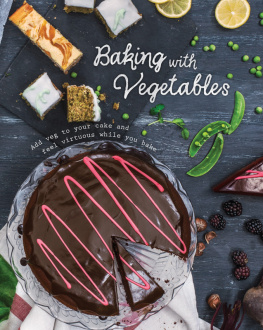

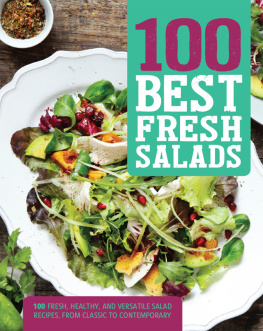

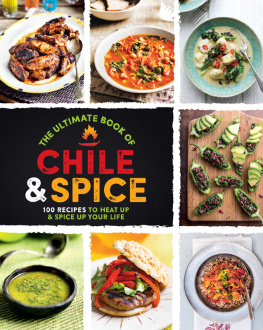
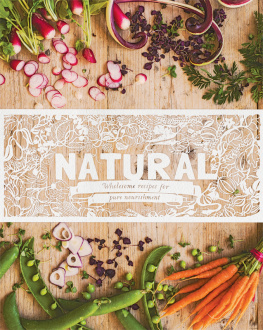


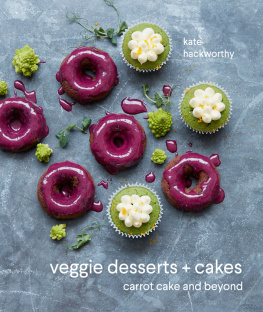









 Though currently on-trend, using vegetables in cakes and baked desserts isnt new. Carrot cake and pumpkin pie are long-time American favourites, and on Italys Amalfi coast a sweet concoction of aubergine and chocolate is a must-have summer dessert. Swedes and Germans are partial to mashed potato and chocolate cakes, and in the Middle East carrot cakes and desserts are classic. In the UK, a 2011 survey established carrot cake as the nations favourite cake. If carrots, pumpkins and potatoes work well, theres no reason why other vegetables cant be given the same treatment. How about cauliflower or parsnips? If you enjoy baking, the possibilities are as exciting as they are intriguing. Given that the word vegetable comes from the Latin verb vegere, meaning to enliven, its hardly surprising that vegetable cakes are such a success. Theyre fun to make, and the vegetables add colour as well as improving texture. If you grow your own, using them in bakes is a great way of dealing with seasonal gluts.
Though currently on-trend, using vegetables in cakes and baked desserts isnt new. Carrot cake and pumpkin pie are long-time American favourites, and on Italys Amalfi coast a sweet concoction of aubergine and chocolate is a must-have summer dessert. Swedes and Germans are partial to mashed potato and chocolate cakes, and in the Middle East carrot cakes and desserts are classic. In the UK, a 2011 survey established carrot cake as the nations favourite cake. If carrots, pumpkins and potatoes work well, theres no reason why other vegetables cant be given the same treatment. How about cauliflower or parsnips? If you enjoy baking, the possibilities are as exciting as they are intriguing. Given that the word vegetable comes from the Latin verb vegere, meaning to enliven, its hardly surprising that vegetable cakes are such a success. Theyre fun to make, and the vegetables add colour as well as improving texture. If you grow your own, using them in bakes is a great way of dealing with seasonal gluts. Climate varies from country to country and region to region, and, with the effect of global warming, the weather is becoming more unpredictable. This means that the season for certain vegetables peas and pumpkins, for example may be shorter or longer, or earlier or later than you might expect.
Climate varies from country to country and region to region, and, with the effect of global warming, the weather is becoming more unpredictable. This means that the season for certain vegetables peas and pumpkins, for example may be shorter or longer, or earlier or later than you might expect.